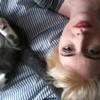Rahel performing at the Whitney Block Party at the Whitney Museum of American Art, New York City. May 2, 2015. Photo: Karl Jacob. Courtesy of the photographer
Advertisement
A child with 'The Rose' (1958–66) by Jay DeFeo, at the Whitney Museum of American Art in New York City. Photo by the author
Advertisement
Block party attendees at the Whitney Block Party at the Whitney Museum of American Art in New York City. May 2, 2015. Photo by the author
Advertisement
A dancer during a performance by A Tribe Called Red at the Whitney Museum of American Art in New York City. May 2, 2015. Photo by Karl Jacob
Advertisement
